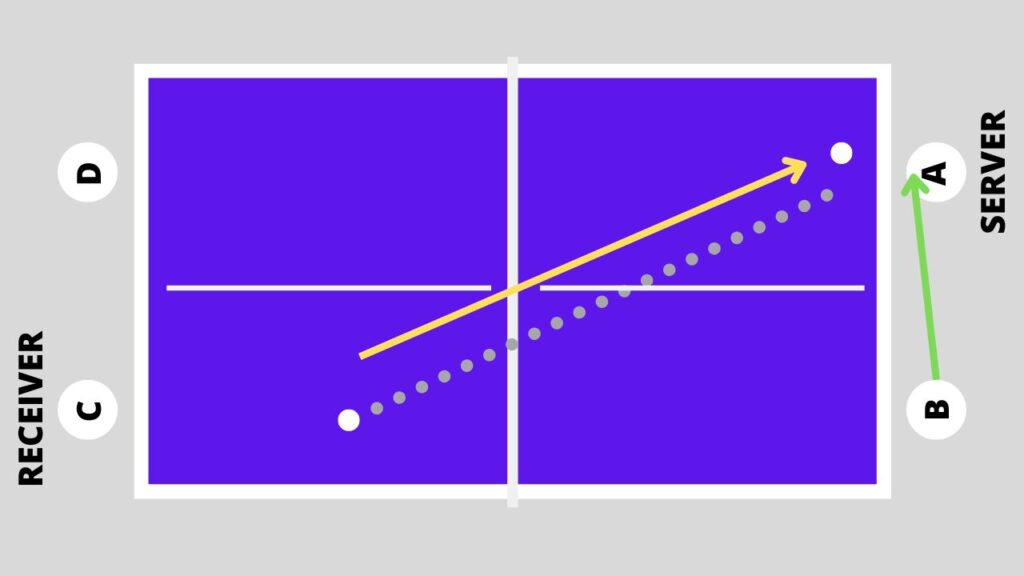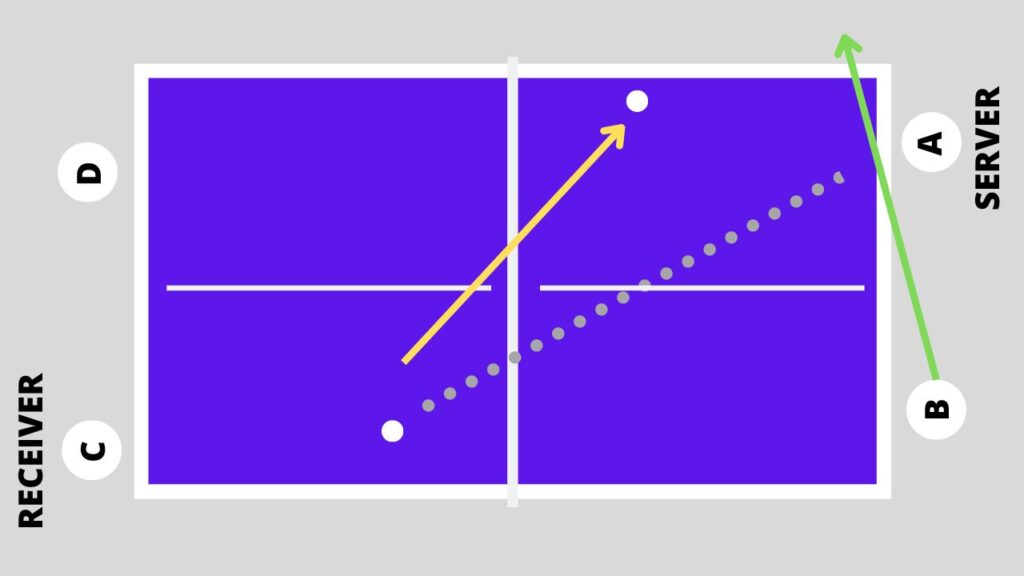Here’s a simple tactic you can use when returning serves in doubles matches. Try to aim your receive very wide on the side the server has just served from…

The width is important. You want the ball to come off the side of the table. This makes it very difficult for player B to get near the ball. If the server (player A) doesn’t move, he will block player B from getting to the ball. Or if player B is a little slow or doesn’t move well, he will struggle to get to the wide return. Either way, you may hit a clean winner.
I find this wide angle is a lot more effective than aiming deep, or even into the corner. This is a lot easier for player B to get to the ball. As you can see, player B has less distance to travel. And a return into this area, may well be setting up player B to hit a strong forehand…

So getting the ball wider is better. Should you receive with your forehand or backhand? This is up to you. Personally, I like to receive with my backhand in doubles. This means I can stand a bit more to the right, giving my partner lots of space for the next shot. Plus it allows me to use my backhand flick for any shorter serves. But other players find it much easier to receive with their forehand, especially if it’s their stronger side. Either will work in executing this tactic.
It’s easier to hit this wide angle, if the serve is a little wide and a little short. You then have the perfect angle to send it back very wide.

If the serve is a little more central, but short or half-long, then it’s still possible to hit this wide angle. When using my backhand, I will come around the side of the table more to give myself the angle I need to go wide.

It’s much harder to hit this wide angle if the serve is deep and central. In this instance you can still try and play back to where the server is standing, but you won’t be able to get such extreme width.

When you have hit this wide angle a couple of times, your opponents may start to expect it. You may even start to see player B inch over to get ready to cover the wide angle. Now you have another option. Return into the opposite corner!

It’s difficult for player B to cover both the very wide angle and also the opposite corner. If he stays to protect the corner – he may find it hard to get to the wide ball. If he moves across too much to cover the wide ball, he will be vulnerable to the corner ball. Player B has to be incredibly alert to your placement. If he is not paying attention, or gets a little indecisive, you can cause a lot of damage with this simple tactic.
I find it works best with a faster return – flicks and topspins. This gives player B less time to react. It can work with push returns, but the push needs to be taken early and should be a little aggressive. A slow, steady push, even if placed very well, will cause fewer problems.
So in summary – aim either very wide or into the opposite corner. Mix up when you go wide and when you go into the corner. Inject some pace into your shot. Be unpredictable. Let me know if it works for you!
Table Tennis Doubles for Champions
For those of you who play a lot of doubles, you may be interested in a new book by Larry Hodges – Table Tennis Doubles for Champions. It has loads of great tips on serve, receive, rallying, positioning, footwork and more. There really is very little information about doubles, so it’s great that Larry has published an entire book on the subject. More information here.
Doubles – group coaching day
I am running a group coaching day on doubles on 22 November 2024. We will focus entirely on the serves, receives, footwork, tactics and team skills needed to succeed in doubles matches. You’ll finish the day with a much clearer idea about how you and your doubles partner can play effectively together. More information here.

